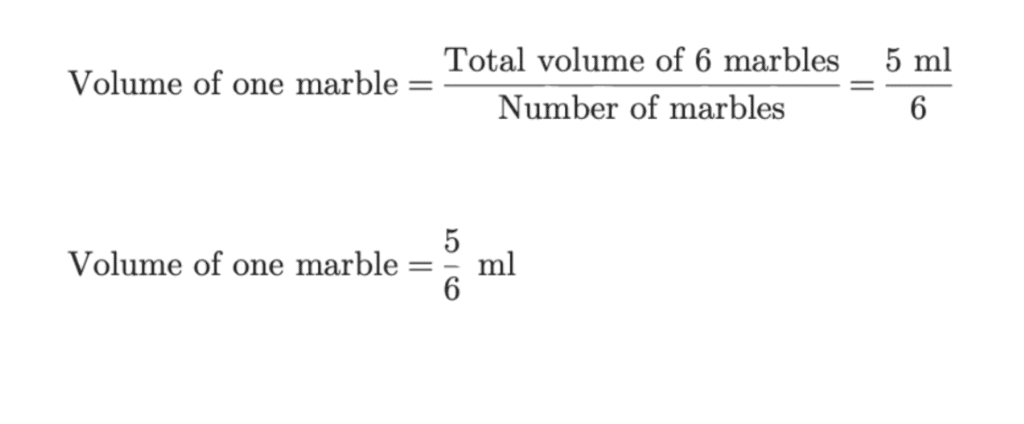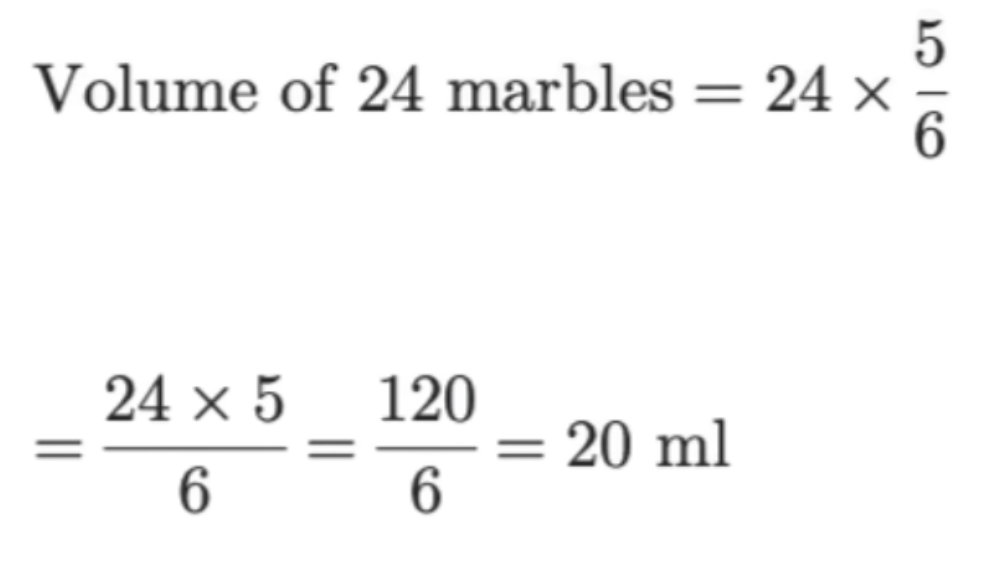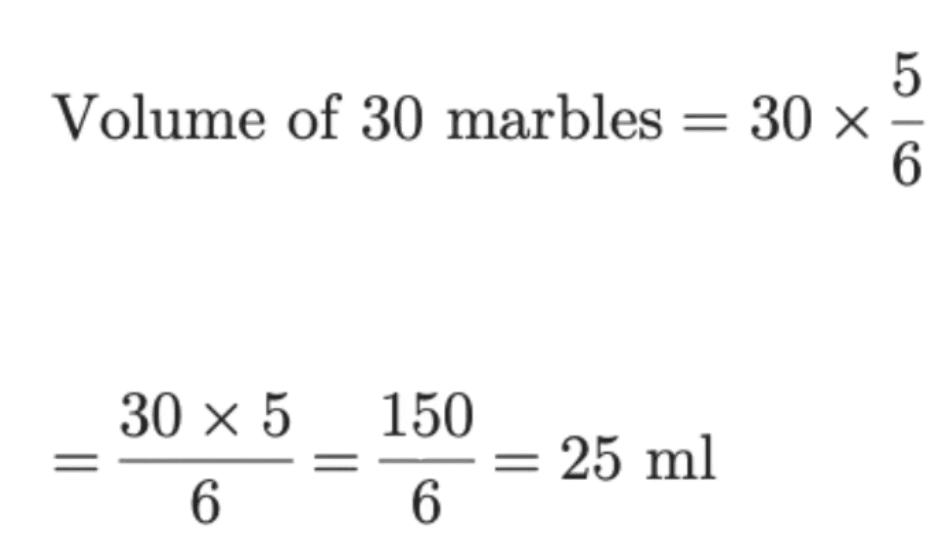Word Problems: How Big, How Heavy | Mathematics for Class 5: NCERT PDF Download
Q1. Find the volume of a cuboid of length 4 cm, breadth 2 cm and height 3 cm?
Ans: The volume of a cuboid can be calculated using the formula:
- Volume = length (l) × breadth (b) × height (h)
Given the dimensions:
- Length = 4 cm
- Breadth = 2 cm
- Height = 3 cm
Substituting the values into the formula:
- Volume = 4 cm × 2 cm × 3 cm = 24 cubic centimetres (cu cm)
Thus, the volume of the cuboid is 24 cu cm.
Q2. A water tank has length 9 cm, breadth 7 cm and height 5 cm. How many cubic metre of water can it hold?
Ans: Given the dimensions of the water tank:
- Length (l) = 9 cm
- Breadth (b) = 7 cm
- Height (h) = 5 cm
The volume of the tank can be calculated using the formula: Volume = l × b × h = 9 cm × 7 cm × 5 cm = 315 cubic centimetres (cu cm).
To convert this volume into cubic metres, we use the conversion factor where 1 cubic metre equals 1,000,000 cubic centimetres: Therefore, the volume in cubic metres is: Volume in cubic metres = 315 cu cm / 1,000,000 = 0.000315 cubic metres.
Q3. Find the volume of a cuboid of side 8cm x 6 cm x 5 cm and a cube of side 9 cm.
Ans: The volume of a cuboid can be calculated using the formula: Volume of a cuboid = length (l) × breadth (b) × height (h) For the given cuboid:
- l = 8 cm
- b = 6 cm
- h = 5 cm
Thus, the volume is: Volume of a cuboid = 8 cm × 6 cm × 5 cm = 240 cm³
For the cube, the volume can be calculated using the formula: Volume of a cube = side × side × side For the cube:
- side = 9 cm
Therefore, the volume is: Volume of a cube = 9 cm × 9 cm × 9 cm = 729 cm³ In conclusion, the cuboid has a volume of 240 cm³, while the cube has a greater volume of 729 cm³.
Q4. A 2 rupee coin weighs 6g. What is the weight of a sack with:
(a) 1500 coins?
(b) 3000 coins?
Ans: Weight of a two-rupee coin = 6 g
- (a) Weight of a sack with 1500 coins = 1500 x 6 = 9000 g = 9 kg
- (b) Weight of a sack with 3000 coins = 3000 x 6 = 18000 g = 18 kg
Q5. The length, breadth and height of the inside of a rectangular box are 100 cm, 80 cm and 60 cm. How many centimeter cubes can be fitted in that box?
Ans: Given the dimensions of the rectangular box:
- Length (l) = 100 cm
- Breadth (b) = 80 cm
- Height (h) = 60 cm
The volume of the box can be calculated using the formula: Volume = l × b × h = 100 cm × 80 cm × 60 cm = 480,000 cubic centimetres (cu cm). Therefore, this box can hold 480,000 cubic centimetres, which means 480,000 unit cubes of 1 cm³ can fit inside it.
Q6. A brick is 24 cm long, 14 cm wide and 10 cm high. Find the space occupied by 500 such bricks?
Ans: Given the dimensions of the brick:
- Length (l) = 24 cm
- Width (b) = 14 cm
- Height (h) = 10 cm
The volume of one brick can be calculated using the formula: Volume = l × b × h = 24 cm × 14 cm × 10 cm = 3360 cm³. To find the space occupied by 500 such bricks, we multiply the volume of one brick by the number of bricks: Total Volume = 500 × 3360 cm³ = 1680000 cm³. Thus, the space occupied by 500 bricks is 1680000 cm³.
Q7. The volume of 6 marbles is 5 ml. Then find the volume of
(a) 24 such marbles
(b) 30 such marbles.
Ans:
Since 6 marbles have a total volume of 5 ml, we can find the volume of one marble by dividing:

Since one marble has a volume of 5/6 ml, the volume of 24 marbles is:

Similarly, for 30 marbles:

Q8. A match box measure 6 cm x 5 cm x 4 cm. Find its volume?
Ans: The volume of a matchbox can be calculated using the formula:
- Volume = length (l) × breadth (b) × height (h)
For the given matchbox dimensions:
- Length (l) = 6 cm
- Breadth (b) = 5 cm
- Height (h) = 4 cm
Substituting the values into the formula:
- Volume = 6 cm × 5 cm × 4 cm = 120 cm³
Thus, the volume of the matchbox is 120 cubic centimetres.
Q9. Find the volume of a cube whose edge is 15cm long?
Ans: The volume of a cube can be calculated using the formula:
- Volume = length × breadth × height
For a cube, all edges are equal, so we can simplify this to:
- Volume = edge × edge × edge
Given that the length of each edge is 15 cm, the calculation becomes:
- Volume = 15 cm × 15 cm × 15 cm = 3375 cm³
Therefore, the volume of the cube is 3375 cubic centimetres.
Q10. How many cubes of side 5 cm can be packed in a box of 30 cm x 25 cm x 20 cm?
Ans: To determine how many cubes with a side length of 5 cm can fit into a box with dimensions 30 cm x 25 cm x 20 cm, we first calculate the volume of the box.
- The volume of a cuboid is calculated using the formula: Volume = length x breadth x height
- Substituting the given values: Volume = 30 cm x 25 cm x 20 cm = 15000 cu cm
- Next, we calculate the volume of one cube: Volume of one cube = side x side x side = 5 cm x 5 cm x 5 cm = 125 cu cm
- To find out how many cubes can fit inside the box, we divide the volume of the box by the volume of one cube: Number of cubes = Volume of the box / Volume of one cube = 15000 cu cm / 125 cu cm = 120
- Therefore, a total of 120 cubes can be packed in the box.
|
31 videos|192 docs|41 tests
|
FAQs on Word Problems: How Big, How Heavy - Mathematics for Class 5: NCERT
| 1. What are some examples of word problems related to size and weight for Class 5 students? |  |
| 2. How can I help my child understand word problems better? |  |
| 3. What strategies can be used to solve word problems about size and weight? |  |
| 4. How do I teach my child to convert units of measurement in word problems? |  |
| 5. Are there any online resources or worksheets for practicing word problems on size and weight? |  |
















